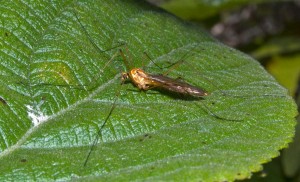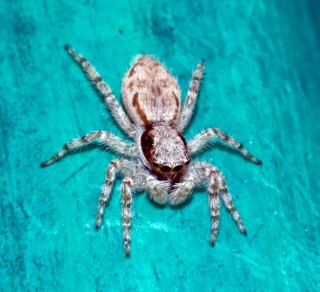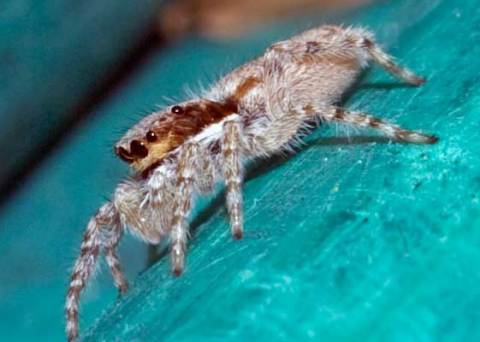Menemerus bivittatus, also known as the Gray Wall Jumper, is a pantropical species of jumping spider that occurs in four of the southern United States: Florida, Louisiana, Texas, and California (here’s an image from Los Angeles that was posted to bugguide a couple of years ago). It’s unclear (to me at least), why it has this disjunct distribution, but it was apparently introduced into Florida from the Old World tropics as far back as 1912. It is associated almost exclusively with human habitations.
Based on a sample size of one (i.e., me), it seems that when a curious backyard naturalist (i.e., me) approaches it with a camera, it waves its chelicerae (the front “feet”) in a warning fashion or threat display, although what kind of threat this 1-cm long arachnid with fangs too weak to penetrate human skin can pose is beyond me. Unfortunately, I wasn’t able to capture this behavior with my camera; every shot I have shows her with her chelicerae demurely folded in front of her:
One thing I discovered about this spider is that it has an incredibly quick reaction time to the flash of a digital camera. When I was taking these pictures, each time I clicked the shutter button while the spider was in one place, in perfect focus, but in the split second between when the flash fired and the exposure was made, the spider literally jumped to a different location. (I suppose the large eyes characteristic of the Salticidae, or jumping spiders, make it rather sensitive to bright lights!)
It was quite a challenge to get any of the shots to come out in focus; I pretty much had to guess how far away and in what direction the spider would jump and prefocus in that general area. A few shots did come out, but I had hoped for far more interesting and diagnostic images, based on how docilely the spider let me approach, despite the foot-waving display. Oh, well. They didn’t turn out too badly, I suppose.
Like most spiders, despite the rather fearsome appearance, they are beneficial to humans on account of their diet. The UF “Featured Creatures” web page for this species mentions that
All free-living stages feed primarily on small Diptera which alight on buildings, although they are capable of capturing large crane flies twice their length, and larger, heavier muscoid flies.
For reference, here’s a crane fly (with 64 North American genera and some 1600 species, family-level (Tipulidae) ID is all you can really get from a photograph):

The etymology of M. bivittatus was fun to figure out. The derivation of the genus name, which translates to something like “moon thigh,” was a bit of a puzzle until I happened to turn to a book I don’t own, but hope to some day: Spiders of North America: An Identification Manual has as its 73rd and last chapter a magisterial etymological dictionary that is a model of scholarship. According to this work, it was Eugène Simon who, in 1868 at only 20 years old was not yet a master of Greek—but the first edition of his Arachnides de France had already been in print for 4 years!—who named this genus. The first part of the name, Menemerus, is supposed to come from the Greek mene, moon, but (had Simon mastered Greek more fully, as he did later in life) it should have ended in –s (menes). The second part of the name, –merus, is Greek for thigh. Apparently Simon meant the name to refer to the crescent-shaped “thigh” of the male palpal femur.
The specific name, bivittatus, is a lot easier: Latin for two-striped (bi + vitta), referring to the stripes on the carapace, easily seen in this view:



